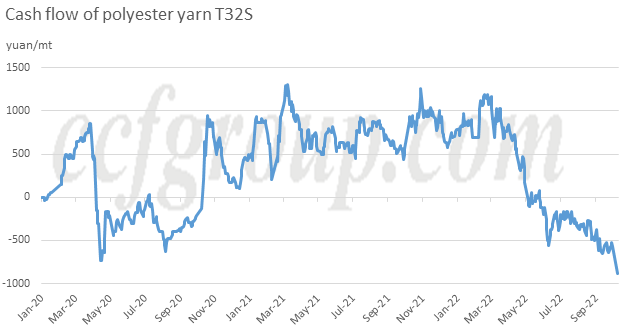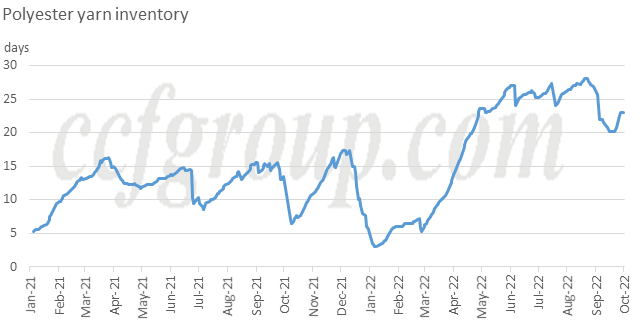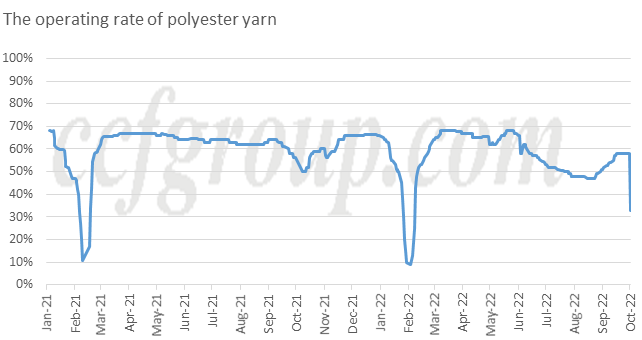Will production cut continue when polyester yarn losses hit new highs?
Oil prices rose sharply during the National Day holiday. For the first few days after the holiday, PSF prices increased by 400yuan/mt, and the traded prices of semi-dull 1.4D moved up to 8,100-8,200yuan/mt. Yet polyester yarn prices hardly followed. By Oct 8, the trade prices of polyester yarn T32S were still at 11,500-11,600yuan/mt in Fujian province, yet it moved up to 11,800-12,000yuan/mt since Oct 10.
1.Polyester yarn loss reached a new high
The processing cost of polyester yarn per ton was 3,500-3,700yuan/mt, and the cash flow of T32S reached -800 ~ -700 yuan/mt, which was the lowest in many years. In early-to mid September, PSF prices in Fujian once approached 8,000yuan/mt, and were at 7,700-7,800yuan/mt in Jiangsu and Zhejiang. The price spread between the two areas reached 300yuan/mt at the maximum. At that time, Polyester yarn mills in Fujian suffered greatest loss across the country, which was close to the current loss level. However, polyester yarn prices are similar among different places at present, thus polyester yarn mills nationwide were at huge losses, exceeding that of all other conventional yarn varieties. However, the silver lining was that due to the price rise, the appreciation of yarn inventory brought about certain short-term dividend, which could reduce the actual loss.

2. Yarn inventory stayed high
This year, the short-term rise and fall of polyester prices failed to entice downstream textile mills, most of whom mainly purchased yarns to meet the minimal requirements. Amid the strong price rise of feedstock, polyester yarn trades didn’t see much improvement, and the stocks kept accumulating instead of dropping. The reason was not only the weak demand, but also other factors such as a sharp decline in foreign orders, the still existing production suspension of some textile mills, and the reemerge of domestic pandemic. The so-called "Golden September and Silver October" peak season actually already ended after the Mid-Autumn Festival.

3. Maintained operating rate and stood on the sidelines
Spinners generally chose production cut or suspension as a last resort, and would only suspend production during the Spring Festival except for force majeure such as the pandemic and “double control”. However, this year, production cut and suspension were frequently seen due to the poor profits and high inventory, and the lowest operating rate even dropped to less than 50% in July and August. More than half of the yarn mills suspended production during the National Day holiday. So far, the operating rate of polyester yarn pegged at 58%, down 10percentage points from the first quarter. Spinners were divided over whether to further cut production or not. Most of them tended to keep waiting due to the hope that sales could turn better as the weather turned cold and the "double 11" shopping festival approached. Besides, parts of textile mills were still shut, and things could turn better as they resumed production. What’s more, yarn mills expected to deplete as much inventory as possible given the current appreciation of stocks. Yan mills that were mainly engaged in export business chose to continue production until the inventory was full.

In general, spinners basically chose to keep waiting despite the huge loss and high inventory at present. The “Double 11” shopping festival could serve as a window when the sales circumstance could be viewed as an indicator to identify whether the coming winter was a bumper winter or a sluggish one.
- Top keywords
- Cotton Price
- Cotton Futures Price
- Cotton Futures
- CZCE
- PTA Futures Price
- Chemical Fiber
- Polyester Prices
- Wool price
- PTA Futures
- Shengze Silk
- China
- Yarn Price
- price
- China Textile City
- Fibre Price
- Benzene Price
- Cotton
- Index
- Cotton Index
- PTA
- fabric price
- NYMEX
- Top 10
- textile industry
- Spot Cotton
- Cotton Yarn
- Polyester Price
- Futures
- PTA Price
- cotton yarn price

